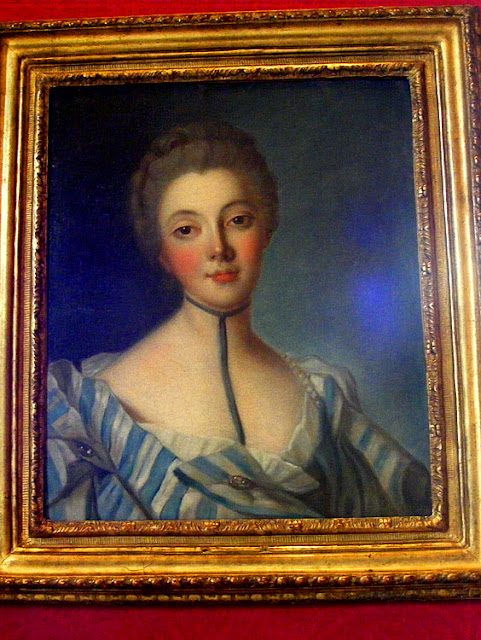Louise Dupin safeguarded the Chateau of Chenonceau during the Revolution. Her husband, Claude Dupin, had been born in Chateauroux in 1686, and was one of Louis XV's fabulously wealthy 'tax farmers'. He had first purchased the prestigious Hotel Lambert in Paris in 1732, and later acquired Chenonceau to augment his already comfortable lifestyle. Louise Guillaume de Fontaine, the illegitimate daughter of his patron, the powerful banker Samuel Bernard, was his second wife.
She was born in Paris in 1706 and was just 16 years old when they married in 1722. A remarkable young woman, she established one of the most popular intellectual salons of the day, where you might encounter Voltaire, Montesquieu, Buffon and Rousseau (who became the couple's private secretary). The latter writes about going to Chenonceau in the autumn of 1747, having a lot of fun, becoming 'as fat as a monk' and writing and performing music together.
 |
| Portrait of Louise Dupin after Nattier, hanging at Chenonceau. |
The Dupin's fell out with Montesquieu, who enjoyed the protection of the King's mistress, Madame de Pompadour. The dispute was because Dupin anonymously published a work supporting financiers that Montesquieu had attacked and countering his political arguments.
Despite being exposed to Revolutionary ideas by those who came to their salon, there is no question that the Dupins were royalists. Louise may have been tolerant, generous and altruistic, she may have written a book about forgotten women of history, but she never really questioned the status quo.
When they took possession of the Chenonceau estate, the Dupins had a complete evaluation of the buildings and gardens. The estimated amount they spent on repairs came to around the equivalent of spending about 46 million euros today.
Inside the chateau, the apartments of Louise of Lorraine, which were on the east facade, were redone and lost their funerary decoration. Likewise, the Capuchin convent Louise had established was refurbished into servants quarters and the internal drawbridge separating the convent from the main dwelling disappeared. The gallery on the second floor was divided into rooms served by a long corridor that led to a small theater. The chapel was not touched.
They purchased the furniture and collection of the previous occupant, the former tenant, the Chevalier d'Aulnay. The library was augmented with numerous works, some of which were very rare. In the grounds, the stable block lost its original ornate roof, which was in very poor condition, and was replaced by much plainer affair. The canals and ponds were destroyed in the time of the Dukes of Vendôme, which meant that the Dupins removed several fountains. The abandoned gardens were cleared of brush, elms were planted along the main avenue, and the vineyards were replanted. Finally, the dikes were consolidated and the moats cleaned.
Chenonceau had been more or less abandoned for a hundred years before the Dupins arrived to save it, and it is supposedly Louise who introduced the difference in spelling between the village and the chateau.
Claude's son from his first marriage, and then his grandson died. Various other male members of the family squandered large portions of the Dupin fortune.
During the French Revolution Louise Dupin settled permanently at Chenonceau, accompanied by her friend, the Countess of Forcalquier, her niece Suzanne Dupin de Francueil, her grandnephews René and Auguste Vallet de Villeneuve, and governess/companion, Marie-Thérèse Adam. The origins of the birth of Marie-Thérèse remain mysterious; she is presumed to be the illegitimate daughter of one of the Dupin men, who had been entrusted to the care of Louise.
Louise was extremely popular with the villagers and so she was able to save the chateau by ruses such as converting the chapel into a firewood store. She allowed a number of portraits of royalty and aristocrats to be destroyed, but managed to save her jewels. Her steward preserved the chateau archive by handing it over to the municipality to be kept as public documents. He also pointed out to the local populace that the plan by enthusiastic Revolutionaries to demolish the chateau was ill-advised. As he said, it is a bridge across the river, and the only one between Montrichard and Bléré. He openly called the Revolutionaries 'enemies of the public good'. Even so, Louise had to fight a legal battle to retain ownership of the chateau and not have it seized as a former royal property being returned to the Nation. Luckily she was able to trace its ownership in private hands since the time of Diane de Poitiers. By this time though, the Dupin money had run out and she was forced to go into debt by borrowing funds.
She died in November of 1799, in her ground floor bedroom on the western side of the chateau (now known as the Francois I room). Louise Dupin was buried according to her last wishes in the woods on the left bank of the Cher, in a sarcophagus resting on large lions' paws, carved and engraved with an epitaph.
We are also on Instagram, so check us out to see a regularly updated selection of our very best photos.

4 comments:
Fascinating post.... and 93 must've been a very good age in those days.
Yes, even for the rich.
Le Bovier de Fontenelle lived to be one hundred years old! He might have been a regular at Mrs. Dupin's.
If you made it past the age of 5 and were rich you had a very good chance of living to at least 70.
Post a Comment